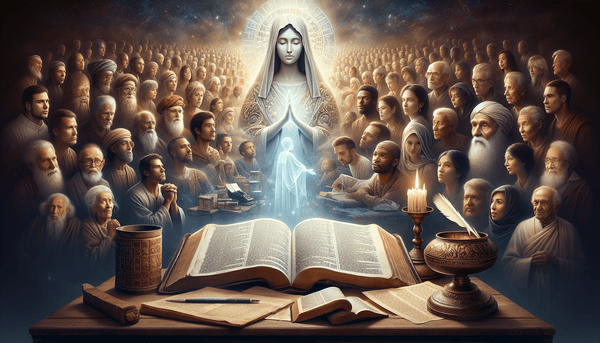The Holy Spirit and the Gift of Tongues at Pentecost
The festival of Pentecost marks a pivotal moment in Christian history, as recorded in Acts 2:2-4. The apostles received a miraculous ability from the Holy Spirit, which manifested as tongues of fire enabling them to speak in various languages. This event was not only a fulfillment of Jesus' promise to send a Helper, as mentioned in John 14:26, but also a divine empowerment for the apostles to spread the gospel. The significance of this event lies in the breaking of language barriers, allowing the apostles to communicate the message of Jesus Christ to diverse crowds in Jerusalem. It was the birth of the Church and the beginning of Christianity's spread, as the apostles were now equipped to be witnesses 'to the ends of the earth' (Acts 1:8). The spiritual gifts, including speaking in tongues, were a testament to God's power and the unity of the early Church, as discussed in 1 Corinthians 12:4-11.
The Command to Saul and the Destruction of the Amalekites
In the narrative of 1 Samuel 15:3, we encounter a difficult command given to Saul: the total destruction of the Amalekites. This command is a part of the larger story of Israel's history and their struggles against a cruel opponent. The Amalekites had attacked the Israelites during their exodus from Egypt, targeting the most vulnerable among them. God's directive to Saul can be understood within the context of divine justice of that era. Saul's failure to fully obey had grave consequences and led to his eventual rejection as king (1 Samuel 15:22-23). This story serves as a sobering reminder of the significance of complete obedience to God's commands. It also teaches lessons on leadership and the weighty responsibility of those in authority to adhere to divine decrees. The historical conflict between Israel and the Amalekites reflects the ongoing struggle between good and evil, and the need for vigilance and faithfulness in following God's guidance.
The Tree of Life in the New Jerusalem
The imagery of the Tree of Life is a powerful symbol in biblical literature, representing God's provision and the fullness of life. In the Book of Revelation, the Tree of Life appears in the New Jerusalem, bearing fruit and leaves that bring healing to the nations (Revelation 22:2). This vision of a restored paradise echoes the Garden of Eden from Genesis 2:9, where the Tree of Life first made its appearance. The prophet Ezekiel also speaks of trees that bear fruit for food and leaves for healing (Ezekiel 47:12), underscoring the theme of restoration and divine care. For believers, the Tree of Life symbolizes the hope and abundance that await in God's eternal kingdom, where life continues unceasingly, and God's blessings are ever-present. It stands as a beacon of hope, reminding us of the righteousness and wisdom that lead to life, as described in Proverbs 11:30, and inspires the transformative journey of faith and prayer.
Conclusion
The biblical narratives we have explored in this post offer a rich tapestry of lessons on divine communication, the power of obedience, and the gift of hope. From the miraculous events of Pentecost to the sobering command given to King Saul, these stories collectively remind us of the many ways in which God's word shapes the destiny of His people. They encourage us to live with a spirit of faithfulness and to trust in the guidance provided by the Holy Spirit. As we reflect on the enduring symbols of the Tree of Life and the testimony of heaven and earth, let us carry forward the message of hope and restoration that is central to the Christian faith. May these insights inspire us to embrace the divine call to obedience and the promise of eternal life with God.






